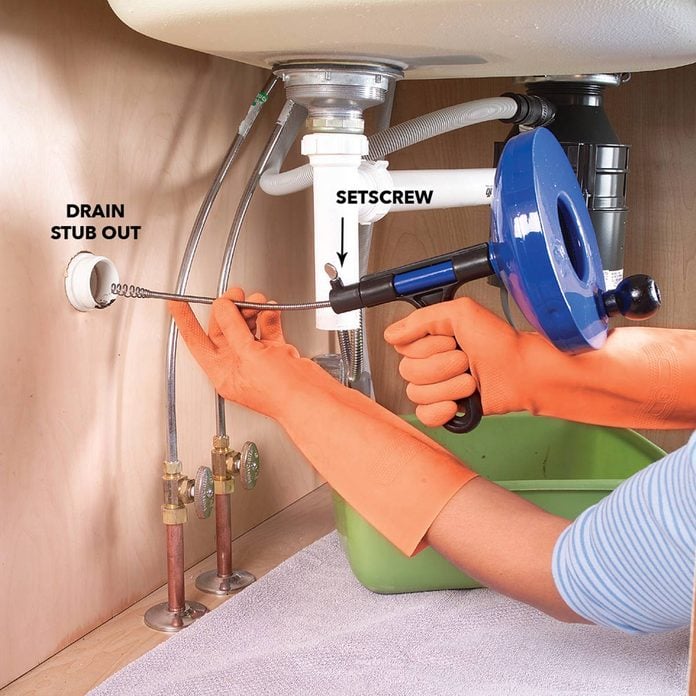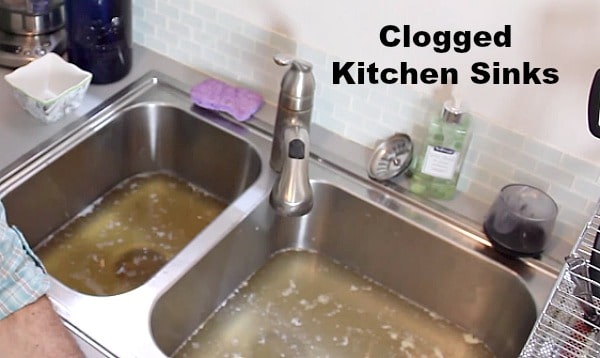We have discovered this great article about Do It Yourself Plumbing Solutions directly below on the internet and felt it made sense to share it with you here.

In this post, we will be checking out five simple actions you could require to release your kitchen area sink from clogs and also conserve you from the pain and embarrassment of handling a blocked kitchen sink.
Blocked cooking area sinks are among one of the most common drain problems homeowners face. As well as what's even more, it's a unpleasant as well as really awkward sight. Visualize going to the sink to do your recipes and discovering that the drain is clogged and water can not flow down easily.
Most clogged drainages are brought on by food debris, soap, oil, as well as fat bits. They clog the sink and also make it hard for water to decrease the drainpipe promptly. While it is appealing to put a call through to the plumbing technicians, there are a couple of DIY hacks you can attempt first before making that telephone call.
1. Sodium Bicarbonate and also Vinegar
Rather than making use of any kind of form of chemicals or bleach, this method is more secure and not damaging to you or your sink. Baking soda as well as vinegar are day-to-day home items utilized for several various other things, and they can do the trick to your kitchen area sink.
Firstly, eliminate any type of water that is left in the sink with a mug.
Then put a great quantity of baking soda down the tubes.
Pour in one mug of vinegar.
Seal the drain opening and also permit it to settle for some minutes.
Pour warm water away to dissolve other stubborn deposit as well as bits.
Following this simple approach might work, and also you can have your kitchen area sink back. Repeat the procedure as long as you deem essential to rid the sink of this particles entirely.
2. Attempt a Plunger
If the issue is not from the waste disposal unit, you can attempt using a plunger. Bettors are standard house devices for this celebration, and they can be available in handy if you use them appropriately. A flat-bottomed bettor is most ideal for this, yet you can make do with what you have is a toilet plunger.
Adhere to the following simple steps to make use of the plunger properly:
Secure the drainpipe with a dustcloth and load the sink with some hot water
Place the plunger in position over the drainpipe and begin diving
Check to see if the water runs freely after a few plunges
Repeat the procedure up until the drainage is complimentary
3. Possibly it's the Garbage Disposal
In numerous cases, the clog might be due to a clog in the disposal. Usage pliers instead.
If this does not function, you can discover the complying with alternative to unblock your kitchen area sink.
4. Utilize a Hanger
Utilizing a cord towel wall mount or a plumber's serpent if you have one can do the method. All you need do is correct the alignment of the wall mount to go down the drain while you thoroughly choose out the particles triggering the blockage.
Run hot water down the drain hereafter to see how effective you were.
5. Use Boiling Water
When confronted with a stopped up sink, the first thing you must attempt is to put boiling water down the drainpipe. That is about the most simple treatment to stopped up sinks as well as drains. Boiling water assists neutralize the particles and particles causing the blockage, specifically if it's soap, oil, or oil fragments, as well as in most cases, it can flush it all down, and also your sink will certainly be back to regular.
Because warm water might melt the lines and also trigger even more damages, do not try this technique if you have plastic pipes (PVC). If you make use of plastic pipelines, you may intend to stay with utilizing a bettor to obtain debris out.
Using this method, switch on the faucet to see exactly how water streams after putting hot water away. If the obstruction lingers, try the procedure again. Nonetheless, the blockage could be much more consistent in many cases as well as call for greater than just boiling water.
Final Words
Trying these few tricks could save you the expenses of having a plumber inspect it. Yet in most cases, a plumber is what we require. In cases where you find it difficult to unclog the sink also after trying all these approaches, it may be time to leave it to the experts.
Contact specialist plumbing business to fix your water drainage problems and various other different home plumbing needs.
Blocked kitchen area sinks are one of the most typical drainage problems homeowners face. Think of going to the sink to do your recipes as well as discovering out that the drainpipe is clogged and water can not flow down conveniently.
They obstruct the sink and also make it hard for water to go down the drain quickly. When encountered with a stopped up sink, the very first point you need to try is to pour boiling water down the drainpipe. Boiling water aids counteract the particles and also debris creating the obstruction, specifically if it's soap, oil, or grease bits, and in numerous instances, it can purge it all down, and your sink will certainly be back to normal.
How to Unclog a Kitchen Sink
Take the Plunge
Start your efforts by plunging. Use a plunger with a large rubber bell and a sturdy handle. Before getting to work on the drain, clamp the drain line to the dishwasher. If you don t close the line, plunging could force dirty water into the dishwasher.
Fill the sink with several inches of water. This ensures a good seal over the drain.
If you have a double sink, plug the other drain with a wet rag or strainer.
Insert the plunger at an angle, making sure water, not air, fills the bell.
Plunge forcefully several times. Pop off the plunger.
Repeat plunging and popping several times until the water drains.Clean the Trap
The P-trap is the curved pipe under the sink. The trap arm is the straight pipe that attaches to the P-trap and runs to the drain stub-out on the wall. Grease and debris can block this section of pipe. Here s how to unclog a kitchen sink by cleaning out the trap:
Remove as much standing water from the sink as possible.
Place a bucket under the pipe to catch the water as it drains.
Unscrew the slip nuts at both ends of the P-trap. Use slip-joint pliers and work carefully to avoid damaging the pipes or fasteners.
If you find a clog, remove it. Reassemble the trap.
If the P-trap isn t clogged, remove the trap arm and look for clogs there. Run the tip of a screwdriver into the drain stub-out to fetch nearby gunk.Spin the Auger
With the trap disassembled, you re ready to crank the auger down the drain line.
Pull a 12-inch length of cable from the auger and tighten the setscrew.
Insert the auger into the drain line, easing it into the pipe.
Feed the cable into the line until you feel an obstruction. Pull out more cable if you need to.
If you come to a clog, crank and push the cable until you feel it break through. The cable will lose tension when this happens.
Crank counterclockwise to pull out the cable, catching the grime and debris with a rag as the cable retracts.

I was made aware of that article on Common Household Plumbing Issues through a good friend on a different blog. Feel free to take the opportunity to share this write-up if you enjoyed it. Many thanks for taking the time to read it.
Stop the flood! Call.